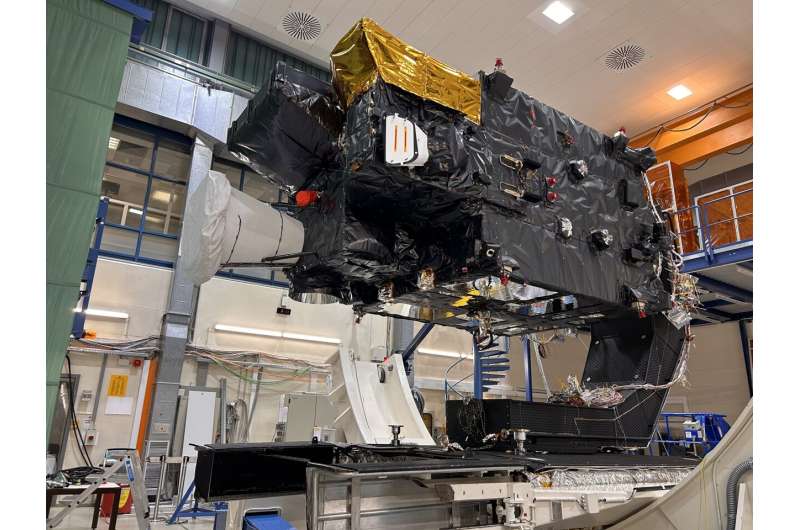This article has been reviewed according to Science X's editorial process and policies. Editors have highlighted the following attributes while ensuring the content's credibility:
fact-checked
trusted source
proofread
Weather satellite passes bake and shake tests with flying colors

As climate change drives more frequent and severe weather events, the need for accurate and timely forecasting has never been more critical. And now, the next Meteosat Third Generation weather satellite has passed its environmental test campaign with flying colors, taking it a significant step closer to launch.
This new generation of satellites is set to transform weather forecasting, particularly in Europe.
Following the spectacular launch of the first MTG-Imager satellite in 2022, which marked the debut of this advanced family of six satellites, all eyes are now on the first MTG-Sounder (MTG-S1) satellite.
While the MTG-Imager significantly improves imaging capabilities over its Second Generation Meteosat predecessor, the MTG-S1 satellite will introduce a groundbreaking infrared sounding capability, enhancing weather prediction accuracy even further.
In addition, it also carries the Copernicus Sentinel-4 instrument to monitor air pollution.
With liftoff slated for next year, the satellite has endured more than seven months of rigorous testing at IABG's facilities near Munich in Germany to ensure that it can withstand the launch and the harsh environment being 36,000 km above Earth's equator, from where it will operate for at least 10 years.
Unlike the classical "shake & bake" approach, the MTG-S1 environmental test campaign followed a "bake & shake" sequence.
This means that the satellite was first subjected to a thermal vacuum test, which entails the whole satellite being placed in a huge vacuum chamber for three weeks and exposed to extreme temperatures, ranging from –180°C to +250°C.
After emerging unscathed, the satellite faced the "shake" part of the campaign. This included a vibration test on an enormous shaker to simulate the juddering of launch, followed by an acoustic test where it was exposed to more than 140 dB, mimicking the noise of rocket ignition and engine burns.
The satellite was in "launch configuration" for both of these tests, meaning that its deployable parts, like its solar arrays and antennas, were folded up. It was also loaded with harmless fluid, as opposed to real propellants, to match its launch weight.
Naturally, engineers seized the opportunity to verify the satellite's actual mass properties, including its weight and center of mass. The predictions proved accurate, with the weight coming in at just over 3.8 metric tons as anticipated.
After the bake and shake tests, a comprehensive set of functional tests were carried out. These included verifying that the mechanisms work correctly for deployable units, as well as for the internal mechanisms essential for instrument operation.
Performance tests, including the instrument data acquisition chain, were repeated to ensure that the satellite's excellent performance had remained intact despite the harsh testing.
And if that wasn't enough, the MTG-Sounder satellite was commanded from the Telespazio and Eumetsat mission control centers, demonstrating end-to-end command and control from when it separates from the rocket through to routine operations and end-of-life procedures.
Finally, the satellite was placed in an anechoic chamber to test its resilience to all types of electromagnetic interference, whether from the rocket or from the satellite itself.
ESA's Christoph Goetz, who oversees all the MTG-S assembly, integration and testing activities, said "All the teams involved are extremely excited about MTG-S1, which will revolutionize weather forecasting.
"The successful completion of this extensive environmental test campaign, just 10 months after the integration of the two MTG-S1 instruments, is a huge achievement and a major step towards the launch of the MTG-S1 satellite.
"We congratulate all of the industrial teams, especially OHB Germany, as the MTG-S's prime contractor, and Thales Alenia Space France, as the MTG mission's prime contractor.
"We also thank Airbus Germany for their support in testing Sentinel-4 and of course IABG Germany for their on-site assistance during the testing."
Over the next couple of months, MTG-S1 will undergo some final checks at OHB in Bremen to prepare it for temporary storage before it is time to ship it to the launch site.
"It is very pleasing to see this significant milestone accomplished and I congratulate all teams involved. The next step will be the Qualification and Acceptance Review that will confirm that the satellite is ready for launch," said James Champion, ESA's MTG Project Manager.
The MTG mission is a cooperation between Eumetsat and ESA.
ESA is responsible for developing and procuring the MTG satellites. The full MTG system is based on a series of two types of satellite: four MTG-Imagers and two MTG-Sounders. Eumetsat defines the system requirements, develops the ground systems, procures the launch services, operates the satellites and makes the data available to users.
The MTG-S satellites carry the Copernicus Sentinel-4 mission's ultraviolet, visible, near-infrared light spectrometer.
Provided by European Space Agency





















